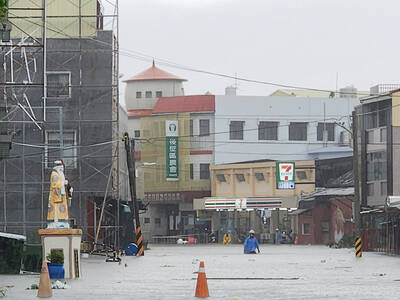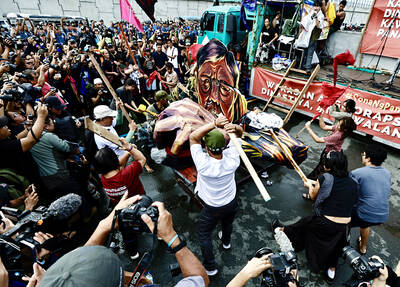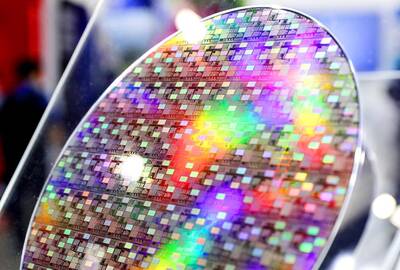China re-opened Tibet to foreign tourists yesterday after claiming victory over the worst unrest there in decades — which led Beijing to all but seal off the area from the outside world.
China’s crackdown in the wake of violent protests in Tibet in March drew international condemnation and led to demonstrations in several countries that disrupted the Olympic torch relay ahead of the Beijing Games in August.
On the provincial Web site, spokesman Zha Nuo (扎諾) said the region would be reopened for tourists — and that having run the torch through the Tibetan capital Lhasa on Saturday without incident showed things were stable.
“After the quick quelling of the ‘March 14’ incident in Lhasa, we have realized a great transitional victory in the fight against separatists,” Zha said.
“The successful Beijing Olympic torch relay in Lhasa on June 21 further proves that currently social stability in Tibet has been further consolidated,” he said.
Zha said two Swedish tourists were to arrive in Lhasa yesterday, followed by four from Singapore on Sunday.
He did not mention when a ban on foreign journalists would be lifted.
“Tibeten tourism is safe, Tibetans are friendly,” he said on Tuesday.
Beijing kicked all tourists and foreigners out of Tibet after violent protests against Chinese rule erupted in mid-March, prompting a massive Chinese security clampdown.
China allowed mainland Chinese tour groups back in at the end of April, followed by visitors from Hong Kong and Macau last month, when it also began allowing tourists from Taiwan.
“It is very hard for us to believe that China will allow free access to Western tourists,” said Paul Bourke, the executive director of the Australia Tibet Council.
“China has always seemed to go to great lengths to prevent Tibetans from having any contact with foreigners. We will be watching with interest to see how this so called ‘opening’ develops,” he said.
Burke said he continues to receive reports from Tibet about a huge military presence in the region and an ongoing police and military lockdown on Tibetan Buddhist monasteries.
Foreign tourists are likely to be watched closely and their movements would be restricted, Bourke said, citing what he said was the stage management of Saturday’s torch relay in Lhasa.
“They may be saying the torch relay was a success, but it was cut from three days to one day and then to a few hours,” Bourke said.
“It was completely stage-managed, with most Tibetans told to stay at home. There was a huge military presence on the streets, and the journalists covering it were all hand-picked and restricted,” he said.
China’s crackdown on the unrest in Tibet sparked international protests that dogged the Olympic torch’s month-long global journey in April before it arrived in China for a nationwide relay.
Exiled Tibetan leaders say 203 people died in the Chinese clampdown on the riots, which began in Lhasa after monks led peaceful protests to mark a 1959 uprising, and later spread across the Tibetan plateau.
China has reported killing one Tibetan “insurgent” and says “rioters” were responsible for 21 deaths.
With the Beijing Olympics set to start in less than two months, China faced the prospect of the Games being tarnished by continued overseas criticism of its Tibet policies if it had kept the region sealed off.
Officials had previously predicted that visitors to the remote region would hit 5 million this year. But just 120,000 people have visited Tibet since the end of April, official figures showed.

Rainfall is expected to become more widespread and persistent across central and southern Taiwan over the next few days, with the effects of the weather patterns becoming most prominent between last night and tomorrow, the Central Weather Administration (CWA) said yesterday. Independent meteorologist Daniel Wu (吳德榮) said that based on the latest forecast models of the combination of a low-pressure system and southwesterly winds, rainfall and flooding are expected to continue in central and southern Taiwan from today to Sunday. The CWA also warned of flash floods, thunder and lightning, and strong gusts in these areas, as well as landslides and fallen

WAITING GAME: The US has so far only offered a ‘best rate tariff,’ which officials assume is about 15 percent, the same as Japan, a person familiar with the matter said Taiwan and the US have completed “technical consultations” regarding tariffs and a finalized rate is expected to be released soon, Executive Yuan spokeswoman Michelle Lee (李慧芝) told a news conference yesterday, as a 90-day pause on US President Donald Trump’s “reciprocal” tariffs is set to expire today. The two countries have reached a “certain degree of consensus” on issues such as tariffs, nontariff trade barriers, trade facilitation, supply chain resilience and economic security, Lee said. They also discussed opportunities for cooperation, investment and procurement, she said. A joint statement is still being negotiated and would be released once the US government has made

SOUTH CHINA SEA? The Philippine president spoke of adding more classrooms and power plants, while skipping tensions with China over disputed areas Philippine President Ferdinand Marcos Jr yesterday blasted “useless and crumbling” flood control projects in a state of the nation address that focused on domestic issues after a months-long feud with his vice president. Addressing a joint session of congress after days of rain that left at least 31 dead, Marcos repeated his recent warning that the nation faced a climate change-driven “new normal,” while pledging to investigate publicly funded projects that had failed. “Let’s not pretend, the people know that these projects can breed corruption. Kickbacks ... for the boys,” he said, citing houses that were “swept away” by the floods. “Someone has

‘CRUDE’: The potential countermeasure is in response to South Africa renaming Taiwan’s representative offices and the insistence that it move out of Pretoria Taiwan is considering banning exports of semiconductors to South Africa after the latter unilaterally downgraded and changed the names of Taiwan’s two representative offices, the Ministry of Foreign Affairs (MOFA) said yesterday. On Monday last week, the South African Department of International Relations and Cooperation unilaterally released a statement saying that, as of April 1, the Taipei Liaison Offices in Pretoria and Cape Town had been renamed the “Taipei Commercial Office in Johannesburg” and the “Taipei Commercial Office in Cape Town.” Citing UN General Assembly Resolution 2758, it said that South Africa “recognizes the People’s Republic of China (PRC) as the sole